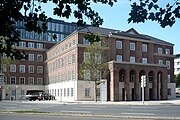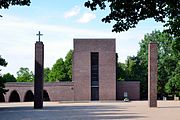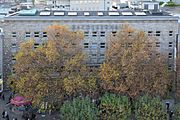Ernst Bode
Ernst Bode (born May 10, 1878 in Nürtingen ; † May 27, 1944 in Breslau ) was a German architect , construction clerk and university professor . From 1920 to 1934 he was the building department of the city of Essen , from 1934 he taught as a professor for urban architecture at the Technical University of Wroclaw .
Life
Ernst Bode was born the son of a senior official geometer. After attending the secondary school in Nürtingen and the grammar school in Rottweil , he worked as a locksmith and fitter to prepare for studying mechanical engineering. From 1897 he studied mechanical engineering and then architecture at the Technical University of Stuttgart under Theodor Fischer, among others . He passed his first state examination to become a government architect ( assessor in public construction) and worked for the city of Rottweil. His second state examination followed in 1908 in building construction. He then worked as an assistant to Paul Bonatz at the Technical University of Stuttgart and the Württemberg State Railway .
In 1912 Bode moved to Gelsenkirchen , where he was responsible for the new building department under city building officer Max Arendt. After the First World War , he returned to Gelsenkirchen in 1918, where he worked from 1919 to 1920 as head of the new building department for the city of Gelsenkirchen. From 1920 it chose the city council of the city of Essen for Assistant Secretary for the building construction department. He built many office, school and functional buildings in downtown Essen based on his own designs. In 1934 he was “pushed out of office as building department” by the new rulers. One reason for this was that Bode had also built a Jewish mourning hall in the Essen park cemetery . The mayor, Theodor Reismann-Grone , appointed by the National Socialists , wrote about Bode's departure: "It is not a great loss for the city [...] of urban planning he [Bode] understands almost nothing". Bode resigned from the city of Essen and took up a professorship for urban architecture at the Technical University in Breslau, where he taught architecture and urban planning.
Buildings and designs
- 1923: Extension of the old Essen town hall (destroyed)
- 1923: Glückaufhaus in Essen (only facades preserved, listed )
- 1924: Park cemetery in Essen-Huttrop (under monument protection)
- 1924: Bode house in Essen
- 1925: Preliminary draft for the Blum House in Essen (implementation planning by Ernst Knoblauch; only facades preserved, listed)
- 1926: Südwestfriedhof in Essen-Fulerum (under monument protection)
- 1928: Preliminary draft for the Lichtburg in Essen (implementation planning by Richard Heydkamp and Curt Bucerius; under monument protection)
- 1928: Sparkasse Frohnhausen in Essen- Frohnhausen , Frohnhausener Strasse 152
- 1928: Baedekerhaus in Essen (only the facade preserved, under monument protection)
- 1930: Stadtbad Altenessen in Essen- Altenessen (under monument protection)
Fonts
- The new central cemeteries in Essen. League of Nations, Geneva 1927.
- New buildings in the city of Essen (= new urban architecture ). Volume 1, FE Hübsch, Berlin 1928. / Volume 2, FE Hübsch, Berlin 1929.
- Children's clinic of the Essen municipal hospitals. Essen 1931.
literature
- Thorsten Ebers: Ernst Bode 1878–1944. In: Deutsches Architektenblatt , year 1997, issue 4, pp. 505–507. ( Deutsches Architektenblatt (DAB), 4/1997. In: arch INFORM .)
- Thorsten Ebers: Ernst Bode. Building policy and buildings in Essen 1920–1934. In: Essen contributions. Contributions to the history of the city and monastery of Essen 121, 2008, pp. 73–233.
- Berger Bergmann, Peter Brdenk (Ed.): Architectural Guide Essen 1900–1960. Klartext-Verlag, Essen 2012, ISBN 978-3-8375-0246-6 , pp. 191-192 (biography).
- Erwin Dickhoff: Essen heads . Ed .: City of Essen - Historical Association for City and Monastery of Essen. Klartext-Verlag, Essen 2015, ISBN 978-3-8375-1231-1 , p. 51 .
Web links
- Ernst Bode. In: arch INFORM .
- Thread Essen: then and now at www.deutsches-architektur-forum.de , accessed on June 22, 2015
Individual evidence
- ↑ a b c Berger Bergmann, Peter Brdenk (Ed.): Architecture Guide Essen 1900–1960. Klartext-Verlag, Essen 2012, ISBN 978-3-8375-0246-6 , p. 42.
- ↑ a b Modern designs, issue 4/1927
- ↑ Berger Bergmann, Peter Brdenk (ed.): Architectural Guide Essen 1900–1960. Klartext-Verlag, Essen 2012, ISBN 978-3-8375-0246-6 , p. 98, no. 41.
- ↑ Berger Bergmann, Peter Brdenk (ed.): Architectural Guide Essen 1900–1960. Klartext-Verlag, Essen 2012, ISBN 978-3-8375-0246-6 , p. 99, no. 42.
- ↑ Berger Bergmann, Peter Brdenk (ed.): Architectural Guide Essen 1900–1960. Klartext-Verlag, Essen 2012, ISBN 978-3-8375-0246-6 , p. 109, no. 52.
- ↑ Berger Bergmann, Peter Brdenk (ed.): Architectural Guide Essen 1900–1960. Klartext-Verlag, Essen 2012, ISBN 978-3-8375-0246-6 , p. 110, no. 53.
- ↑ Berger Bergmann, Peter Brdenk (ed.): Architectural Guide Essen 1900–1960. Klartext-Verlag, Essen 2012, ISBN 978-3-8375-0246-6 , p. 112, no. 55.
- ↑ Berger Bergmann, Peter Brdenk (ed.): Architectural Guide Essen 1900–1960. Klartext-Verlag, Essen 2012, ISBN 978-3-8375-0246-6 , p. 116, no. 59.
- ↑ Berger Bergmann, Peter Brdenk (ed.): Architectural Guide Essen 1900–1960. Klartext-Verlag, Essen 2012, ISBN 978-3-8375-0246-6 , p. 121, no. 64.
- ↑ Berger Bergmann, Peter Brdenk (ed.): Architectural Guide Essen 1900–1960. Klartext-Verlag, Essen 2012, ISBN 978-3-8375-0246-6 , p. 127, no. 70.
| personal data | |
|---|---|
| SURNAME | Bode, Ernst |
| BRIEF DESCRIPTION | German architect, construction officer and university professor |
| DATE OF BIRTH | May 10, 1878 |
| PLACE OF BIRTH | Nürtingen |
| DATE OF DEATH | May 27, 1944 |
| Place of death | Wroclaw |





